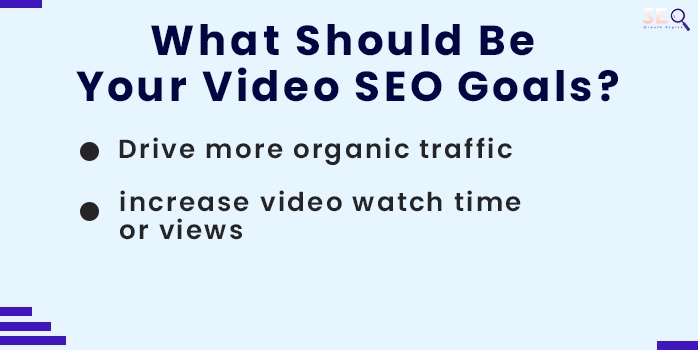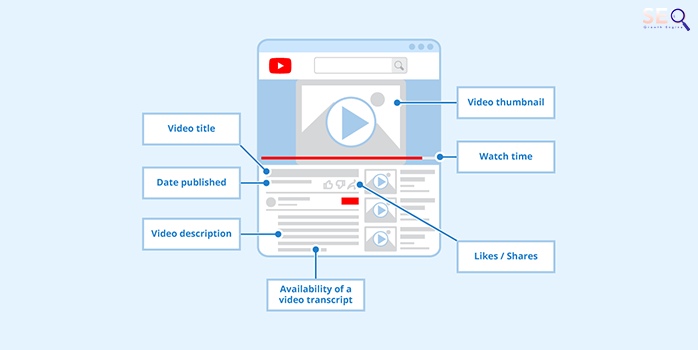Are you looking to increase your video’s visibility and drive more traffic to your website?
Video SEO optimization is the answer.
It is an compelling way to create an impactful digital presence and engage with your customers.
With the right video SEO strategy, you can generate more leads and conversions, thus increasing your ROI.
In this guide, we will discuss the important elements of video SEO optimization, how it works and the best practices to get your videos to the top of the search engine result page.
We’ll also go through the tools and resources that can help you maximize your video SEO efforts, so you can reach your online marketing goals.
Hey, just a heads up before we start reading the article. We’ll be mainly focusing on YouTube since it’s the most commonly used platform for hosting videos.
Keep reading!
What Is Video SEO?

Video SEO (search engine optimization) is the process of optimizing videos for search engines.
It involves optimizing the video’s content and ensuring the video is properly indexed and shows up in search engine results.
This helps to increase the video’s visibility and drive more web traffic to it.
The optimization process typically involves keyword research and optimizing the title, description, and other metadata associated with the video.
Additionally, video SEO involves optimizing the URL, the video thumbnail, and the placement of the video on the website.
These elements are essential for ensuring indexed video.
By using SEO, businesses can ensure that their videos are seen by more people, ideally resulting in increased website traffic, leads, and sales.
Evolution Of Video SEO
Video SEO has changed drastically in the past few years as online video consumption has become increasingly popular.
It’s a trend that has gained momentum in recent years, especially since DSLR cameras became more accessible in the late 2000s.
Thanks to YouTube, and other video hosting platforms, it’s now easier for marketers to create videos and share them online without needing to be experts in videography.
Have you noticed how videos are everywhere these days? It’s hard to go online without stumbling upon one.
Most of us carry smartphones that can shoot pretty good videos anytime, anywhere.
But because of this video craze, getting a high ranking in the universal search results is much more challenging.
Additionally, marketers now use aggregator sites to increase further visibility, optimize the video’s landing page, and use rich snippets to give it an edge.
With the advent of YouTube and other video hosting platforms, content creators have had to increasingly focus on optimizing their videos for the algorithm.
What Should Be Your Video SEO Goals?

Do you know your goals?
When it comes to video SEO optimization, having a clear idea about your goals is a must.
The most important goal for video SEO is to drive more organic traffic to your video content.
When setting video SEO goals, it’s important to also think about increasing video watch time or views.
Another important goal for video SEO is to ensure the content is shareable.
How To Optimize Videos For SEO?
As businesses try to connect with their target audiences and get noticed in search engine results, optimizing their videos for SEO is becoming more and more crucial.
By Optimizing Videos For SEO, You Can Ensure:
- Your content is targeting the right audience.
- You’re getting a prominent place in search results.
So, if you want to enhance your video’s SEO (search engine optimisation), here are some helpful tips to consider:
1. Be Absolutely Clear With Your Objectives

You must tailor your videos to a specific goal.
Ask yourself: what goal am I trying to achieve with this video?
Is it to increase sales, drive web traffic, or build brand awareness?
Once you have established your objectives, you can design your video to meet them.
When creating videos, ensure that the content is relevant and engaging.
It should be concise and to the point, with a strong call to action.
Additionally, include relevant keywords in your title, description, and tags to improve your chances of being found in video search results.
Finally, pay attention to the video format and resolution, as these can affect the performance of the video.
In sum, consider your objectives when designing videos and craft your content accordingly.
Utilize relevant keywords and tags to help optimize your video for search engines.
Finally, ensure the video format and resolution are of high quality. Doing so will help you achieve the best results with your video SEO strategies.
2. Keyword Research

Many need to be clearer about Video keyword research with article keyword research.
There are BIG differences between them. Why?
Clearly, YouTube (or other video hosting platforms) and Google work differently.
What works for Google will not necessarily work for YouTube (or other video hosting platforms).
For instance, a keyword that receives thousands of monthly searches every month on Google may only get around a hundred searches on YouTube.
It’s pretty interesting how different platforms can affect the popularity of certain topics.
Another reason is that YouTube mostly works in auto suggestions. Let’s say you watch videos mostly related to SEO.
Here your chances are higher that YouTube suggests videos pertaining to digital marketing.
That doesn’t mean you avoid optimizing your videos for searches. However, you’ll only get a fraction of traffic from searches.
Hey, next time you’re looking for a keyword to search for, remember that what’s popular on one platform might be less popular on another. For example, a super popular keyword on Google might get less attention on YouTube.
So if you’re looking to find something specific on YouTube, check out what keywords are popular on that platform. That way, you’re more likely to find the content you’re looking for.
3. Choose The Right Video Hosting Platform

When it comes to video SEO optimization, picking the right video hosting platform is essential.
There are a number of different video hosting platforms such as YouTube, Vimeo, Wistia and Brightcove, each with its own pros and cons.
So how do YOU decide which is best for your needs?
Without any secret, YouTube is the most popular video hosting platform. It’s free and easy to use and offers a variety of customization options.
Here you can share your videos without any hassle. And you can also embed in other websites.
Vimeo is another popular platform and offers more control over customization and privacy settings than YouTube. It also has a wide range of tools and analytics to help track the success of your videos. Vimeo is great for high-quality videos and offers more storage options than YouTube.
Wistia and Brightcove are both platforms specifically designed for business use. They offer analytics, customization options and advanced features, such as being able to add a call-to-action button to videos. They both offer a free plan and are ideal for businesses who need to host and track a large number of videos.
Final Takeaway: Select the most suitable video hosting platform depending upon your goal, budget and functionality.
4. Introduce Strong CTAs:

Let’s say you’ve created top-of-the-world video content but cannot drive users to take any action.
This is where a call to action comes in.
CTAs, or calls to action, are pivotal for successful video SEO optimization.
These are text prompts that let them know what the next step should be.
Whether that’s asking them to subscribe, watch more videos, or visit your website – having actionable CTAs can help you get better results from your video SEO optimization efforts.
When creating CTAs, be sure to keep them clear and concise.
Make sure you maintain a simple language that viewers can quickly understand.
You should also place them at the beginning, end, and throughout your video.
This way, viewers won’t miss them and will be more likely to take action.
Finally, make sure to use visuals where appropriate. Use visuals to draw the viewer’s attention and make the CTA more appealing.
A well-crafted CTA can help you get more views, leads, and conversions from your video SEO optimization efforts.
5. Add Key Elements Of SEO-Optimizations

Only a few people know the importance of transcripts in SEO optimization (video).
Simply put, video transcripts are written versions of the video, including sound effects. They’re useful because they help search engines understand what the video is about.
This makes your video more discoverable in search engine results and gives viewers valuable information about the video’s content.
Additionally, transcripts are useful for viewers that may be deaf or hard of hearing, so you’ll be helping make the video more accessible.
You should also make sure to distribute the video on multiple channels. This will increase the number of views and thus make it easier for search engines to discover the video.
Additionally, be sure to use keywords in the video’s title, description, and tags. This will help search engines identify the video and make it easier to find.
6. Create The Right Type Of Video Content

The secret to SEO Optimization is choosing the right type of video.
First, you’ll want to ensure your video content is relevant to your target audience.
Ask yourself, “Would my ideal customer be interested in watching this video?” If the answer is NO, then it’s probably not the right type of content for your video SEO efforts.
Next, you’ll want to ensure that your video content is engaging. Making sure your videos are informative, entertaining, and visually appealing will go a long way in helping you reach your audience.
Finally, you’ll want to keep the duration of your video content in mind. Videos that are too long or short can make your audience lose interest.
By creating the right type of video content for your audience, you’ll have a better chance of achieving success with your video SEO efforts. Keep these tips in mind when creating your videos, and you’ll be sure to make an impact on your audience.
7. Optimize Your Web Page Around The Video

Ensuring you optimize your web pages for your video. It helps search engines understand that you are hosting a video and aids in SEO Optimization.
Start by adding relevant keywords to the page and a meta description that summarizes the purpose of the video.
Additionally, optimize the page title to include the video title, and ensure search optimized URL.
Include the video within the page’s content and a link to the video within the text. Doing this will help search engines recognize the relevance of the video to the page and allow the video to appear in relevant searches.
8. Other Tactics Should Go Along With SEO

Having an awesome video isn’t enough. It will help if you promote it to get the most out of it.
Don’t rely solely on SEO to do the job.
SEO Optimization is an important mechanism to get your video seen, but it’s far from the only one.
You should promote your video across multiple channels to reach the widest audience possible.
Utilize social media, such as Facebook, Twitter, Instagram, and LinkedIn, to advertise your video.
Please share the video with your followers and encourage them to share it with their networks. You can also use influencers to promote your video.
Consider email marketing to notify your subscribers of your latest video. You can also include a link to the video in your email signature.
Partnering with other businesses, like bloggers and podcasts, on cross-promotional campaigns can also help get your video noticed.
Depending on your video’s content, consider submitting it to video-sharing platforms like YouTube, Vimeo, and Dailymotion.
Using SEO in tandem with these other promotion methods will ensure that your video gets the attention it deserves.
9. Don’t Embed The Same Video In Multiple Places

A common mistake many make when it comes to video SEO optimization: embedding the same video in multiple locations across the web. Not only does this not help your SEO, but it can also hurt you.
When a search engine crawls the web, it looks for unique content. If it finds the same content in multiple places, it will lower your ranking because it assumes that the content is not valuable.
So, it’s important to ensure your video is only embedded once. That way, the search engine will see it as unique content, and you’ll get a higher ranking.
Another thing to remember is that you must place your video on a page relevant to the video’s content. In other words, make sure that the page where you embed the video is related to what the video is all about.
This will help to ensure that the search engine will see it as valuable content, and you’ll get a higher ranking.
Finally, be sure to track your video’s performance. This will help you to determine if embedding the video in multiple places is helping or hurting your SEO.
After you follow the tips diligently, you ensure maximize your video SEO optimization and get the best possible results.
Bottom Line
We really hope this guide was helpful to you! Now it’s time to put these tips into action. Take the time to try them, and you’ll start to notice a big difference.
Don’t rush it, though—make sure you take the time to implement these strategies and see how they work for you.
We’re confident that they’ll make a big impact on your results!
If you need further SEO help, feel free to reach out to us.
Read Also:








